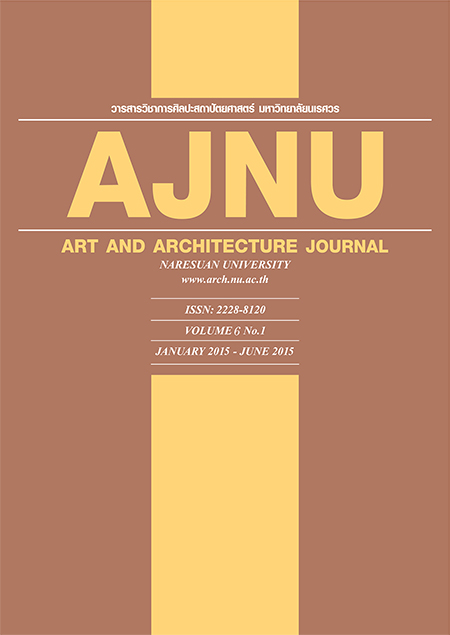การพัฒนางานหัตถกรรมไม้ไผ่ในภาคอีสาน DEVELOPMENT OF BAMBOO HANDICRAFT IN ISAAN
Main Article Content
Abstract
การวิจัยเพื่อพัฒนางานหัตถกรรมไม้ไผ่ในภาคอีสาน ครั้งนี้ ผู้วิจัยได้กำหนดวัตถุประสงค์ในการวิจัยไว้ 4 ประการ
คือ 1) ศึกษาปัจจัยที่มีอิทธิพลต่อการพัฒนางานหัตถกรรมไม้ไผ่ 2) ศึกษาพฤติกรรมของผู้บริโภคและปัจจัยที่ส่งผลต่อการตัดสินใจซื้อ
สินค้าหัตถกรรมไม้ไผ่ในภาคอีสาน 3) ออกแบบและพัฒนาเตาอบไม้ไผ่ที่เหมาะสมกับงานหัตถกรรม และ 4) กำหนดแนวทางในการ
ออกแบบและพัฒนางานหัตถกรรมไม้ไผ่ในภาคอีสาน ผลการวิจัย พบว่า ผู้บริโภคมีพฤติกรรมการซื้อของผู้ซื้อสินค้าหัตถกรรมไม้ไผ่
มากกว่า 1 ครั้งต่อปี สมาชิกในครอบครัวที่เป็นผู้ใช้สินค้าส่วนใหญ่คือ คุณแม่ นอกจากนั้น ผู้ที่แนะนำให้ผู้ซื้อซื้อสินค้าหัตถกรรมไม้
ไผ่มักจะเป็นคนในครอบครัว ปัจจัยทางการตลาดที่มีผลต่อการตัดสินใจซื้อสินค้าหัตถกรรมไม้ไผ่ พบว่า ให้ความสำคัญกับปัจจัย
ส่วนประสมทางการตลาด หรือ 4 P’s คือ Product Price Place และ Promotion ตามลำดับ สำหรับปัจจัยสิ่งแวดล้อมที่มีผล
ต่อการตัดสินใจซื้อ พบว่า ปัจจัยที่มีผลมากที่สุดคือ มีความเป็นเอกลักษณ์ของวัฒนธรรมไทย รองลงมาคือ เป็นค่านิยมของ
สังคมไทย และผลิตภัณฑ์ช่วยสร้างการยอมรับในกลุ่ม เมื่อพิจารณาโดยรวมของปัจจัยต่างๆ ทั้งปัจจัยด้านการตลาด และปัจจัย
สิ่งแวดล้อมที่มีผลต่อการตัดสินใจซื้อสินค้าหัตถกรรมไม้ไผ่นั้นพบว่า ปัจจัยที่มีผลต่อการตัดสินใจซื้อสินค้าหัตถกรรมไม้ไผ่มากที่สุดคือ
ความมีเอกลักษณ์ของความเป็นไทย ( = 3.52) รองลงมาคือ คุณภาพของผลิตภัณฑ์ ( = 3.34) และความเหมาะสมของ
ราคาผลิตภัณฑ์และค่านิยมในการใช้สินค้าไทย ( = 3.32) สำหรับการศึกษาปัจจัยที่มีอิทธิพลต่อการพัฒนางานหัตถกรรม
ไม้ไผ่ในภาคอีสาน ผู้วิจัยได้พิจารณาจากปัจจัยที่เกี่ยวข้อง 3 ส่วน ซึ่งพบว่า ส่วนของภูมิปัญญาท้องถิ่น ผู้ผลิตส่วนใหญ่นิยม
พัฒนางานจากภูมิปัญญาดั้งเดิม เช่น การใช้ภูมิปัญญาท้องถิ่นในการอบรมควัน (ร้อยละ 60.61) 2) ส่วนปัจจัยใน
ด้านต่างๆ ที่เกิดจากการส่งเสริมผลิตภัณฑ์ OTOP ในปีพ.ศ. 2544-2551 พบว่า สภาวะเศรษฐกิจมีผลกระทบต่องาน
หัตถกรรมไม้ไผ่อยู่ในระดับมากที่สุด (ร้อยละ 57.58) นโยบายภาครัฐมีผลกระทบต่องานหัตถกรรมไม้ไผ่อยู่ในระดับมากที่สุด
(ร้อยละ 57.58) การให้ความช่วยเหลือของส่วนราชการส่วนใหญ่ให้ความช่วยเหลือด้านการอบรมให้ความรู้ (ร้อยละ 51.52)
สิ่งที่ส่วนราชการให้ความช่วยเหลือนั้นตรงกับความต้องการ (ร้อยละ 48.48) และสามารถนำมาประยุกต์ใช้ได้มาก (ร้อยละ 45.45)
ผู้ผลิตส่วนใหญ่ต้องการให้ส่วนราชการช่วยเหลือในด้านการสนับสนุนงบประมาณ (ร้อยละ 66.67) สภาพแวดล้อมในการทำงานมี
ผลต่อการพัฒนางานไม้ไผ่ (ร้อยละ 66.67) หากมีการพัฒนาวัสดุทดแทนผู้ผลิตส่วนใหญ่เห็นว่าไม่เหมาะสม (ร้อยละ 87.88)
ผู้ผลิตส่วนใหญ่เห็นว่าผู้ซื้อมีค่านิยมในการใช้ผลิตภัณฑ์ไม้ไผ่เนื่องจากเป็นวัสดุธรรมชาติ (ร้อยละ 100.00) และในส่วนของการ
วิเคราะห์รูปแบบการพัฒนางานหัตถกรรมไม้ไผ่ในภาคอีสาน พบว่า ผลิตภัณฑ์ไม้ไผ่มีทั้งจุดเด่น จุดด้อย จุดเด่นเห็นว่า
เป็นวัสดุธรรมชาติ (ร้อยละ 60.61) จุดด้อยที่เห็นว่า มีปัญหามอด รา (ร้อยละ 81.82) และข้อเสนอแนะแนวทางพัฒนา
งานหัตถกรรมไม้ไผ่ในภาคอีสาน ผู้ผลิตส่วนใหญ่เห็นว่า ควรศึกษาหาวิธีการแก้ไขปัญหามอด รา (ร้อยละ 51.52) ข้อมูลที่ได้จาก
การศึกษาทั้งหมด ผู้วิจัยได้นำมาเป็นข้อกำหนดเบื้องต้น ในการทดลองออกแบบและสร้างเตาอบรมควันต้นแบบ จำนวน 4 เตาอบ
โดยเตาอบหมายเลข 4 เป็นเตาอบรมควันที่ได้รับการทดสอบแล้วว่า มีความเหมาะสมกับการนำมาใช้ในกระบวนการผลิตงาน
หัตถกรรมไม้ไผ่ ทั้งงานจักสานและงานเฟอร์นิเจอร์
For this research on bamboo handicraft in the Isaan region, the researcher set 4 research
objectives as follows: 1) Study factors influencing the development of bamboo handicraft. 2) Study the
behavior of the consumers and factors relating to the decisions of purchasing bamboo handicraft products
in Isaan. 3) Design and develop bamboo ovens that are appropriate for handicraft. 4) Determine the
direction for the design and development of bamboo handicraft in Isaan. For the research results, on the
purchasing behavior of the consumers of bamboo handicraft products, each purchased more than once a
year. The household members who made up the majority of the consumers were the mothers. Moreover,
the ones who recommended the purchasers to purchase bamboo handicraft were usually members of the
households. As for marketing factors affecting the decisions of purchasing bamboo handicraft, it was found
that importance was given to the factor of marketing mix, or 4 P’s: product, price, place, and promotion,
respectively. As regards the environmental factor with greatest influence on purchasing decisions, it was
discovered that the factor with greatest impact was the uniqueness of Thai culture in the products; the
factors with minor impact were the value of Thai society and the fact that the products helped induce
acceptance among the group. The overall consideration of the factors – the marketing factors and the
environmental factors affecting the decisions of purchasing bamboo handicraft products – yielded that the
factor with greatest influence on the decisions of purchasing bamboo handicraft products was the
uniqueness of being Thai ( = 3.52). The ones with minor influence were product quality ( = 3.34) and
reasonability of product prices and the value of using Thai products ( = 3.32). For the examination of
factors influencing the development of bamboo handicraft in Isaan, based on 3 relevant factors, the analysis
yielded that, in respect of local wisdom, most manufacturers developed their work from traditional wisdom,
such as the local wisdom of smoke baking (60.61%). 2) As for factors of different aspects resulting from the
promotion of OTOP products in 2001-2008, the economic condition had impact on bamboo handicraft at
the highest level (57.58%). The governmental policies did so at the highest level (57.58%). The support
from the governmental sector was mostly in the form of education (51.52%); the support corresponded to
the needs (48.48%), and the knowledge acquired wherefrom could be applied to a high degree (45.45%).
The majority of the manufacturers wanted the governmental sector to provide financial support (66.67%).
The work environment affected the development of bamboo work (66.67%). Substitute material
development was regarded by the majority of the manufacturers as inappropriate (87.88%). Most
manufacturers thought that consumers valued the use of bamboo handicraft for its natural material
(100.00%). As for the analysis of the style of development of bamboo handicraft in Isaan, bamboo products
had both strength and weakness. Most manufacturers regarded that the strength of bamboo work was its
natural material (60.61%) and the weakness was the weevil and mold problem (81.82%). For
recommendation of a guideline for the development of bamboo handicraft in Isaan, the majority of the
manufacturers viewed that study should be done to find methods to solve the problem of weevil and
mold (51.52%). All the data acquired from the study were used in the determination of pre-requisites in the
experiment of designing and creating 4 model smoke ovens. The fourth is the one that has been tested and
proved to be suitable for using in the manufacturing process of bamboo handicraft, both wickerwork and
furniture.

